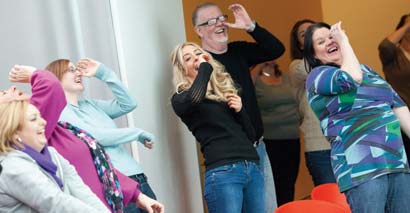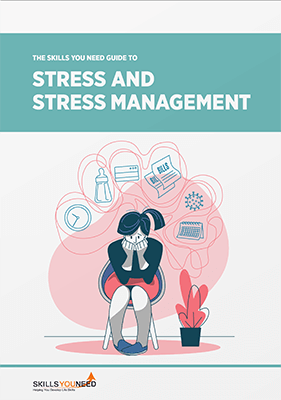Laughter Therapy as Stress Relief
See also: Tips for Dealing with StressLaughing is an excellent way to reduce stress in our lives, and can help you to cope with and survive a stressful lifestyle.
Laughter provides a full-scale workout for your muscles and unleashes a rush of stress-busting endorphins. Since our bodies cannot distinguish between real and fake laughter, anything that makes you giggle will have a positive impact. You do not need to be happy or have a sense of humour to benefit from a good laugh.
Laughter therapy aims to get people laughing in both group and individual sessions and can help reduce stress, make people and employees happier and more committed, as well as improve their interpersonal skills.
Laughter therapist Keith Adams explains the background of therapeutic laughter.
Therapeutic Laughter

By way of introduction, I am a member of the UK Laughter Network. We are a group of professionals with a common goal to bring more happiness and laughter into people’s lives through therapeutic laughter.
Many individuals have contributed to the history of modern therapeutic laughter.
Here are just a few:
Norman Cousins, celebrated political writer
In 1979, Cousins published a book Anatomy of an Illness in which he described a potentially fatal disease he contracted in 1964 and his discovery of the benefits of humour and other positive emotions in battling the disease.
Cousins found, for example, that ten minutes of mirthful laughter gave him two hours of pain-free sleep. His story baffled the scientific community and inspired a number of research projects.
Dr William F. Fry, psychiatrist, Stanford University, California
Dr Fry began to examine the physiological effects of laughter in the late 1960s and is considered the father of ‘gelotology’ (the science of laughter).
Dr Fry proved that mirthful laughter provides good physical exercise and can decrease your chances of respiratory infections. He showed that laughter causes our body to produce endorphins (natural painkillers).
Dr Lee Berk, Loma Linda University Medical Centre
Inspired by Norman Cousins, Dr Berk and his team of researchers from the field of psycho-neuro-immunology (PNI) studied the physical impact of mirthful laughter.
In one study heart attack patients were divided into two groups: one half was placed under standard medical care while the other half watched humorous videos for thirty minutes each day.
After one year the ‘humour’ group had fewer arrhythmias, lower blood pressure, lower levels of stress hormones, and required lower doses of medication. The non-humour group had two and a half times more recurrent heart attacks than the humour group (50% vs. 20%).
Dr Hunter (Patch) Adams
Immortalized in film by Robin Williams, Patch inspired millions of people by bringing fun and laughter back into the hospital world and putting into practice the idea that “healing should be a loving human interchange, not a business transaction”.
He is the founder and director of the Gesundheit Institute, a holistic medical community that has been providing free medical care to thousands of patients since 1971. He is the catalyst for the creation of thousands of therapeutic care clowns worldwide.
Dr Annette Goodheart
Goodheart is a psychotherapist and inventor of laughter therapy and laughter coaching. For 36 years she has been using laughter to treat cancer, AIDS, depression, and other illnesses and been teaching at universities, schools, companies, organisations and public events, bringing laughter to every part of the world.
Dr Madan Kataria, creator of Laughter Yoga
In March 1995 this medical doctor from Mumbai, India was writing an article Laughter - The Best Medicine for a health journal. In particular, he was impressed by Norman Cousins’ book Anatomy of an Illness and the research work by Dr Berk. Dr Kataria discovered that the body cannot differentiate between acted and genuine laughter.
He then created a range of laughter exercises including elements of role-play and other techniques from his days as an amateur dramatic actor. Realizing the importance of child-like playfulness, he developed further techniques to stimulate this within a group. Laughter Yoga was born and is now accepted all over the world.
Oxford University/Royal Society
In September 2011, academics from Oxford University published research demonstrating that continuous laughter significantly increases people’s pain threshold, by as much as 10%.
To read the article abstract click here.
Laughter Yoga

Laughter Yoga includes four things:
Clapping in rhythm to ‘ho-ho-ha-ha-ha’.
Breathing and stretching.
Child-like play.
Laughter exercises.
Laughter comes from the body not the mind.
The picture here is of one of my participants at the Liverpool Mutual Homes workshop – it shows just how infectious laughter yoga can be!
When you take part in a laughter workshop you get a release of endorphins, giving you a "feel good” factor; the whole body relaxes and stress and tension is reduced.
You also get an aerobic exercise. Laughter tones your muscles and improves your respiration – and your immune system is boosted which helps you to resist disease.
You can easily acquire the skills to lead a laughter yoga workshop. You will need an outgoing personally, be a good communicator and quite happy to lead a group of people into laughter.
Keith Adams - Laughter Aspirations
Keith Adams is a member of the UK Laughter Network, a group of professionals with a common goal to bring more happiness and laughter into people’s lives through therapeutic laughter.
Continue to:
Yoga Nidra Meditation
Self-Hypnosis

